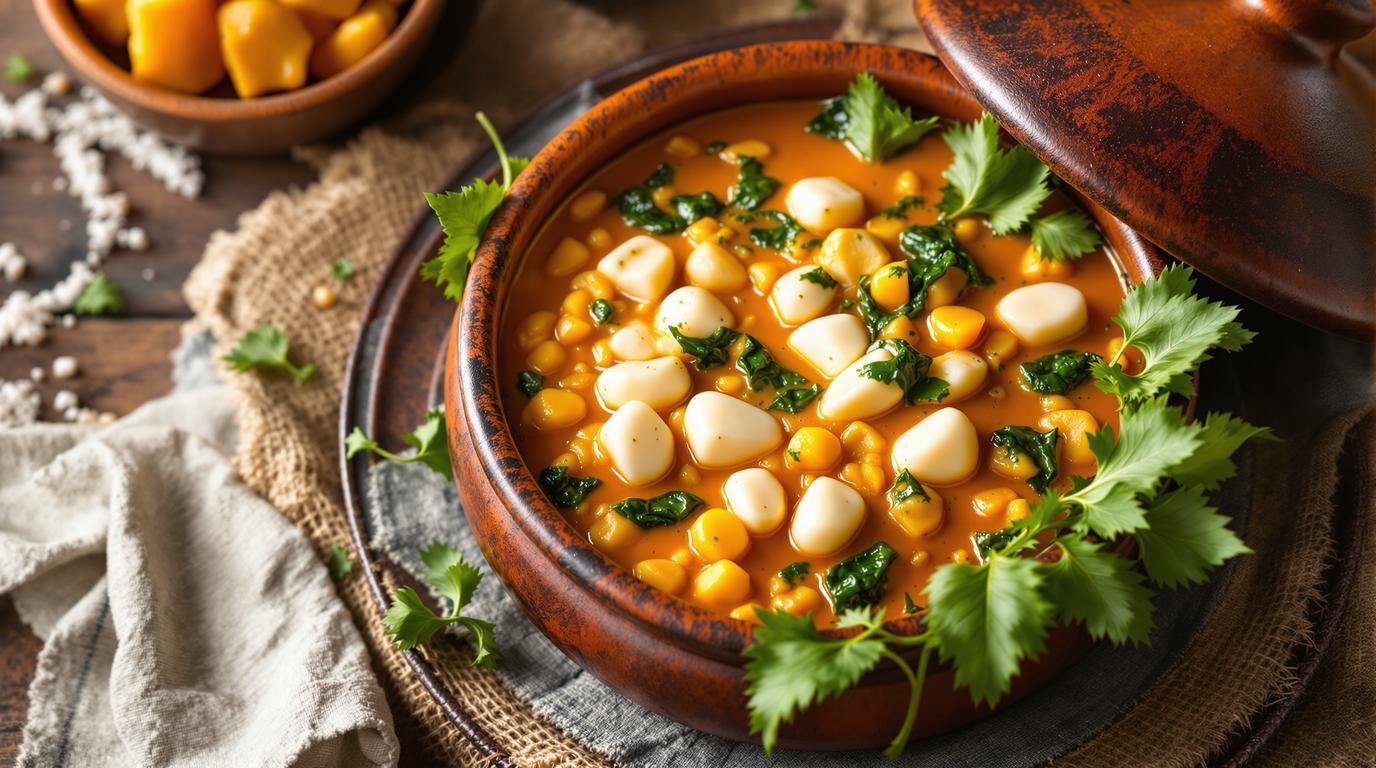The first time I encountered Egusi soup was during my culinary travels through West Africa, where I watched a Nigerian grandmother transform humble ingredients into pure magic. Standing in her kitchen with sunlight streaming through open windows, I observed as she carefully ground melon seeds between smooth river stones, her hands moving with the practiced rhythm of decades. “The secret,” she whispered to me, “is in how you treat the egusi seeds.” Twenty years later, I still hear her voice whenever I prepare this rich, velvety stew that has become a cornerstone of West African cuisine. While technically a soup, its hearty thickness makes it more like a stew—nutritious, deeply satisfying, and bursting with complex flavors.
The Story Behind Egusi Soup 📖
Egusi soup originates from the southern regions of Nigeria, particularly among Igbo and Yoruba communities, though it’s beloved throughout West Africa including Ghana. This ancestral dish showcases the ingenious way African cooks transform protein-rich melon seeds into a creamy base that carries the flavors of meat, seafood, and vegetables. Regional variations abound—from the creamier Ijebu style that omits leafy greens to Eastern Nigerian versions that incorporate fresh herbs like mint or coriander after cooking. In many communities, a generous pot of Egusi soup symbolizes hospitality and is often prepared for honored guests and celebrations.
Essential Ingredients 🧾
The soul of this dish lies in ground egusi seeds (about ¾ cup or 100g), which create the distinctive creamy texture. If you can’t source egusi seeds from African specialty markets, pumpkin seeds make a respectable substitute, though with a milder flavor profile. You’ll also need:
- 750g (1.65 lbs) beef, goat, or lamb, cut into stew-sized chunks
- 2 large red onions (about 175g), finely diced
- 2 tablespoons ground crayfish (can substitute shrimp powder)
- 4 medium tomatoes (250g) or equivalent canned tomatoes
- 500g fresh spinach or pumpkin leaves (substitute with kale or collards)
- ¼ cup palm oil or vegetable oil (60ml)
- Salt, black pepper, and smoked paprika to taste
I’ve watched home cooks debate the perfect greens for hours—while traditionalists insist on bitter leaf or pumpkin leaves, spinach makes a perfectly acceptable substitute in American kitchens. What’s non-negotiable is using properly ground egusi and allowing it to form those characteristic curds during cooking.
Step-by-Step Instructions 📝
- Prepare the Meat Base: Start by simmering your meat with half an onion, a tablespoon of salt, and 2 cups of water until fork-tender, about 30-40 minutes. Reserve this flavorful broth—it forms the foundation of your soup.
- Create Your Aromatics: In a heavy-bottomed pot, heat your oil over medium heat and sauté the remaining onion until translucent, about 5 minutes. Add the cooked meat (reserving the broth), ground crayfish, and smoked paprika. Allow these to dance together for 5-7 minutes, developing a deep flavor base.
- Add the Egusi Magic: Grind your egusi seeds with about ½ cup water to form a thick paste. Now comes the crucial technique: rather than stirring the paste directly in, add spoonfuls of the paste into the hot oil without stirring. Let them poach undisturbed for about 5 minutes—this creates those beautiful characteristic curds that give authentic Egusi its distinctive texture.
- Build Your Soup: Add the tomatoes, reserved meat broth, and black pepper. Cover and simmer on low heat for 15 minutes, allowing everything to meld together into a harmonious whole.
- Finish with Greens: Add your finely chopped greens and cook for just 4-5 minutes until wilted but still vibrant. Adjust seasoning to taste—a good Egusi soup should be well-seasoned with a perfect balance of salt, umami, and subtle heat.
Chef’s Note: Lightly toast your egusi seeds before grinding to unlock their nutty flavor potential. This single step elevates the entire dish from good to unforgettable. I learned this technique from a chef in Lagos who explained that toasting the seeds is like “waking them up” before they perform their starring role.
Secret Techniques 🤫
The defining characteristic of exceptional Egusi soup lies in achieving that perfect curd formation. The cardinal rule: resist the urge to stir too early when adding the egusi paste. Patience here yields those beautiful, tender curds that make each spoonful a textural delight. Another technique I’ve perfected over the years is adjusting consistency with reserved broth, adding it incrementally to achieve that perfect balance between “stew-like” and “soupy.” Too thick, and it becomes pasty; too thin, and you lose the luxurious mouthfeel that makes Egusi so satisfying.
Serving & Presentation Tips 🍽️
In Nigeria, Egusi soup is traditionally enjoyed with starchy sides that provide the perfect vehicle for sopping up the rich sauce. Serve alongside fufu, pounded yam, or eba (made from cassava). For a more accessible alternative, try serving with steamed rice or even crusty bread. The traditional way to eat is with your right hand, scooping a small ball of starch, making an indentation, and using it to gather the soup—a sensory experience that connects you directly to the food.
This hearty, nutritious soup exemplifies how culinary wisdom transforms simple ingredients into extraordinary meals. As they say in Nigeria, “Egusi soup will make you lick your fingers before washing your hands!” Whenever I make this dish, I’m transported back to that sunlit kitchen in Lagos, reminded that authentic cooking isn’t just about following steps—it’s about honoring traditions while creating something deeply satisfying. For more culinary adventures, check out Vietnam’s coffee secrets, crispy potato techniques, or transform overripe bananas into fluffy pancakes. For another traditional feast, explore Greek Kleftiko, or learn how simple celery salt can elevate everyday dishes.
